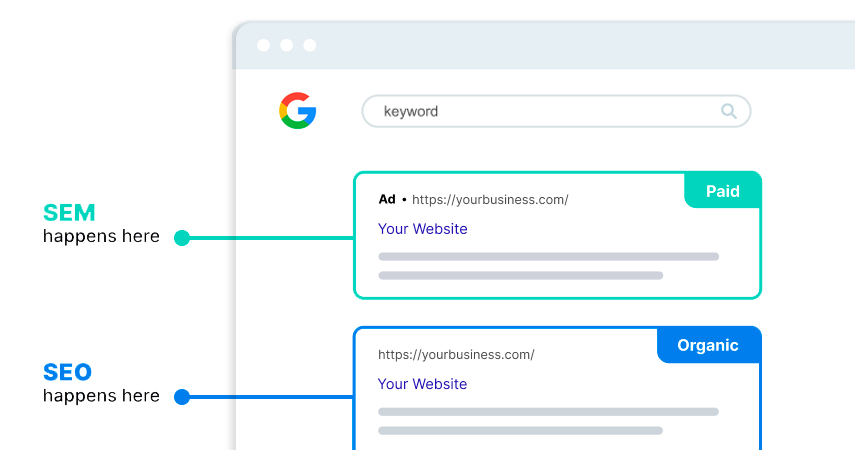Search Engine Optimization (SEO) is an indispensable element of your digital marketing strategy. It plays a pivotal role in ensuring that a broader segment of your target audience discovers your business online, thereby enabling you to extend your reach and boost your revenue.
On this page, we will delve into the fundamentals of SEO and address some frequently asked questions, including:
What is SEO in digital marketing?
SEO in digital marketing is a strategic approach centered on enhancing your website’s visibility in search results on search engines such as Google. This encompasses employing diverse techniques to optimize your website, aiming to facilitate a clearer understanding for both search engines and consumers.
How does SEO in digital marketing work?
Now that you have the answer to the question “what is SEO in digital marketing,” let’s delve into how it operates.
When you execute an SEO strategy, you optimize your website to appear in the Search Engine Results Pages (SERPs) for keywords and phrases associated with your business. Simultaneously, you submit your website URLs to Google and other search engines to secure visibility in the SERPs.
Keywords constitute the words and phrases sought by your target audience online. For instance, if your business specializes in selling running sneakers, your audience may conduct searches using keywords like “running sneakers” or “women’s running sneakers” and various related terms.
Search engines strive to deliver the best user experience, which is reflected in the multitude of ranking factors determining your position in the SERPs. The objective is to showcase the most relevant and high-quality websites in the results, providing users with the information they seek.
Through SEO, you implement techniques that enhance your website’s user experience, ensuring that it provides valuable answers to your audience’s queries. Some examples of SEO techniques include:

- Enhancing mobile user-friendliness with responsive design
- Optimizing website navigation for seamless user experience
- Crafting tailored content to address users’ queries
- Strategically incorporating keywords and phrases across site pages and content
- And additional optimizations for enhanced performance
By implementing an SEO strategy, your enhancements send favorable signals to search engines, signaling that your website delivers substantial value to users. Consequently, search engines will elevate the ranking of your website in the Search Engine Results Pages (SERPs).
Securing a top position in the search results is imperative, given that 75% of users do not venture beyond the first page of results.
How do search engines work?
At the core of SEO lies the search engine framework, a pivotal element in unraveling why SERPs highlight specific pages over others. These sophisticated systems meticulously analyze all websites across the Internet, organizing information for user convenience.
So, how do search engines, including Google, Bing, and Yahoo, process such a vast amount of data? They follow a three-step process — crawling, indexing, and ranking — to produce the most robust results.
The anatomy of a search result
Let’s start by diving into what a search engine results page looks like. A SERP consists of paid and organic results.
Paid results consist of websites who’ve paid Google to appear at the top of the search results. You can identify them by the “sponsored” tag that appears above the title.
Following the three paid results, the subsequent section displays a comprehensive list of organic results constituting the remainder of the page. These results comprise websites that haven’t paid for placement in the results. Google selects these websites based on various ranking factors, including relevance, keyword targeting, user experience, and more.
Ranking

What is the difference between organic search vs. paid search?
When delving into the realm of digital marketing, particularly SEO, it becomes crucial to distinguish between organic and paid search and comprehend their disparities.
In essence, the key distinction lies in the cost: organic search is free, while paid search incurs costs.
Upon submitting a search query to a search engine, the displayed results encompass both paid and organic listings. Paid listings are identifiable by the attached label “Ad.” Clicking on a paid listing incurs a cost for the advertiser. Conversely, selecting an organic listing involves no expense for the website owner.
SEO primarily revolves around optimizing your website to achieve higher rankings in organic search results.
While paid search holds value and serves specific purposes, the return on investment (ROI) from organic search makes SEO a strategic investment for any business. Understanding the fundamentals of SEO and its workings empowers you to enhance your site’s search result rankings and increase traffic, making it an essential skill to acquire.
How does SEO in digital marketing compare to SEM and PPC?
SEO (Search Engine Optimization), SEM (Search Engine Marketing), and PPC (Pay-Per-Click) are interconnected yet distinct components of digital marketing. Let’s break down their differences:
SEO (Search Engine Optimization): This is an organic, non-paid strategy focused on optimizing your website to improve its visibility in search engine results. SEO involves various techniques like keyword optimization, content creation, and enhancing website structure. The goal is to increase organic (unpaid) traffic to your site.
SEM (Search Engine Marketing): SEM is a broader term encompassing both organic strategies (like SEO) and paid strategies. While SEO is a component of SEM, SEM also includes paid advertising on search engines. It involves optimizing your website for better visibility in search engine results pages (SERPs) and utilizing paid advertising, like Google Ads, to increase your presence.
PPC (Pay-Per-Click): PPC is a specific form of paid advertising falling under the SEM umbrella. In PPC campaigns, advertisers pay a fee each time their ad is clicked. Google Ads is a common platform for PPC advertising. It allows businesses to bid for ad placement in a search engine’s sponsored links when someone searches for a relevant keyword.
In summary, SEO is the process of optimizing your website to rank higher in organic search results, SEM involves a broader approach encompassing both organic and paid strategies, and PPC specifically refers to the paid advertising model where advertisers pay for each click on their ads. Each plays a unique role in a comprehensive digital marketing strategy.
What are the benefits of SEO in digital marketing?
SEO is an indispensable strategy that can propel your business to new heights. Explore the multitude of benefits it offers in digital marketing:
Boost Online Visibility: Implementing an SEO strategy elevates your online visibility and enhances brand awareness. As your website climbs the search result rankings, a broader audience discovers your business online.
Increase Website Traffic: Higher rankings in the SERPs drive increased traffic to your website. This influx of users engages with your content, explores your products and services, ultimately contributing to heightened sales and revenue.
Stand Out from Competitors: SEO empowers you to surpass your primary competitors in search results, elevating your credibility as an industry expert. This distinction helps you shine among competitors, attracting new customers to your business.
SEO emerges as a valuable and continuous strategy, allowing you to acquire new customers and perpetually promote your products and services online, thereby driving sustained sales and revenue growth for your business.






